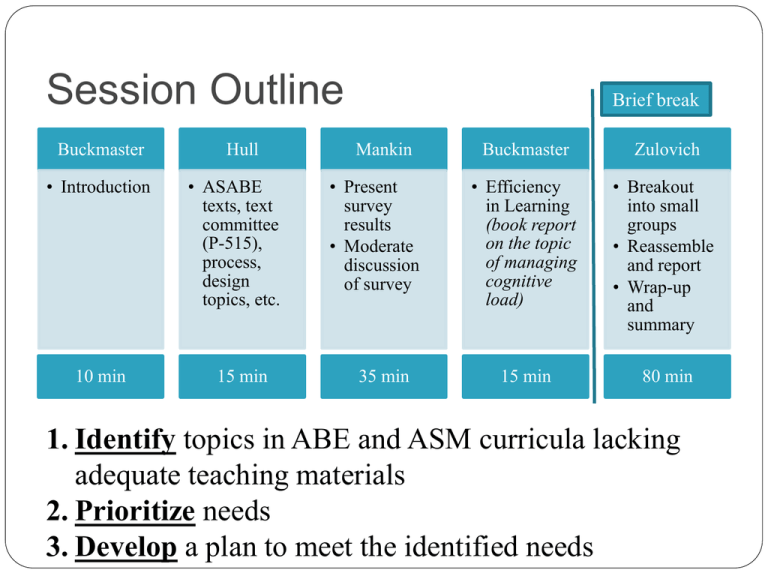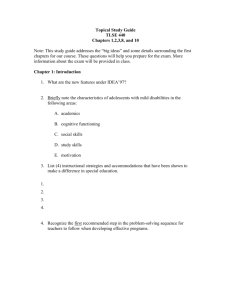Managing Cognitive Load - College of Engineering
advertisement

Session Outline Buckmaster • Introduction 10 min Hull • ASABE texts, text committee (P-515), process, design topics, etc. 15 min Brief break Mankin • Present survey results • Moderate discussion of survey 35 min Buckmaster Zulovich • Efficiency in Learning (book report on the topic of managing cognitive load) • Breakout into small groups • Reassemble and report • Wrap-up and summary 15 min 80 min 1. Identify topics in ABE and ASM curricula lacking adequate teaching materials 2. Prioritize needs 3. Develop a plan to meet the identified needs Managing Cognitive Load A “book report” of Efficiency in Learning: Evidence-based guidelines to manage cognitive load. Clark, Nguyen, and Sweller. 2006. Wiley & Sons. ISBN 0-7879-7728-4 Dennis R. Buckmaster Purdue University dbuckmas@purdue.edu Presentation Outline Explain the fit to this RAP session Define cognitive load Discuss “effects” (explain with examples) Allow easy questions Provide you with a couple very good URLs References (repeated later) Efficiency in Learning: Evidence-based guidelines to manage cognitive load. Clark, Nguyen, and Sweller. 2006. Wiley & Sons. ISBN 0-7879-7728-4 http://www.scitopics.com/Cognitive_Loa d_Theory.html (Cognitive Load Theory by John Sweller) http://www.editlib.org/p/25229 (CLT and the Role of Learner Experience: An abbreviated review for Educational Practitioners by Anthony Artino) http://carbon.cudenver.edu/~bwilson/cog /sweller.html (Improving Traditional Instruction: CLT by Brent Wilson) Relevance to today Aspects of adequate Content (depth, date, audience fit) Quality (style, examples, problems, etc.) Planning to meet the needs Sweller and others have some very good things to teach any of us who teach or prepare teaching resource materials Cognitive Load Theory Universal set of instructional principles and evidence- based guidelines that offer the most efficient methods to design and delivery instructional environments in ways that best utilize the limited capacity of working memory. Cognitive Load Theory (CLT) 1. Is universal (all types of content, media, learners) Technical matter Soft skills Text Visuals Audio “Whether you are a classroom instructor or developer of training materials for workbooks or computers, cognitive load theory applies to you” 2. 3. CLT offers principles and related instructional guidelines CLT is evidence-based Cognitive Load Theory CLT leads to efficient learning 5. CLT leverages human cognitive learning processes 4. Types of Cognitive Load Intrinsic Mental work imposed by the complexity of content – associated with the instructional objective Germane (relevant) Mental work imposed by instructional activities that benefit the instructional goal – diverse examples or applications are an example Extraneous (irrelevant) Wastes limited mental resources that could be directed to germane load Remember: working memory is limited Just a bit of vocabulary Working memory Central element of human cognition responsible for active processing of data during thinking, problem solving and learning; has limited capacity Long-term memory A relatively permanent mental repository of knowledge and skills in the form of schema that provide the basis for expertise. Schema A memory structure located in long-term memory that is the basis for expertise. Allows chunking of many elements of information into a single element. Sometimes called mental models. Can be large or small and grow over time. (similar to scaffolding) Automaticity Status of any knowledge or skill that has been used so many times that it can be activated from long-term memory and applied using minimal working memory resources. Schema Example #1 Source: Renius, K. and R. Resch. 2005. Continuously variable tractor transmissions. ASABE Dist. Lecture No. 29. 37 pp. Schema Example #2 Source: Hydraulics and Pneumatics Fluid Power ebook, Edition 1 Fluid Power Basics. Chapter 21 (Practice Circuits). http://www.hydraulicspneumati cs.com/200/eBooks/Article/Tr ue/79292/ Some of this (CLT mumbo-jumbo) … will seem obvious … I knew that will seem counter-intuitive … I don’t believe it will strike a cord … Oh, that is why … will reinforce the way you do things … I’ll keep on … will lead you to experiment … I’ll try it a different way next time Split Attention Effect Extraneous cognitive load caused by separation of related instructional elements Examples: Text and figures Tutorial manual and computer screen Note taking during lectures Fixes: Use cues and signals when content is complex Integrate text and graphics on the same page or screen Provide content summaries Avoid computer “manuals” Which is a quicker read? With Legend No Legend 250 Engine torque (ft-lb) Engine torque (ft-lb) 250 200 150 100 77 hp model 52 hp model 50 0 77 hp model 200 150 52 hp model 100 50 0 500 1000 1500 2000 Engine speed (rpm) 2500 500 1000 1500 2000 Engine speed (rpm) 2500 Modality Effect Working memory includes separate processing areas for visual and auditory information Using auditory mode along with visual makes most efficient use of limited working memory resources Complex visuals are understood more efficiently when explanatory words are presented in audio modality than when presented in written modality Employs dual encoding which is a combination of words and visuals Example follows with 3 presentation methods Graphic & static (textbook style) text Graphic and my explanation Graphic and animated text How often do students go home? Average time between visits to home (days) 50 45 40 35 30 25 20 15 10 5 0 0 50 100 150 200 250 Distance from college to home (miles) Larger bubbles represent more students Vertical axis is time between visits home Horizontal axis is distance from college to home As students live farther from home, they go home less frequently The curve appears to be a bit exponential Not many students live extremely far from home Average time between visits to home (days) How often do students go home? 50 45 40 35 30 25 20 15 10 5 0 0 50 100 150 200 Distance from college to home (miles) 250 Average time between visits to home (days) How often do students go home? 50 45 40 35 Vertical axis is time between visits home 30 25 20 Larger bubbles represent 15 more students 10 5 0 0 Horizontal axis is distance from college to home 50 100 150 200 Distance from college to home (miles) 250 Average time between visits to home (days) How often do students go home? 50 45 40 35 30 25 20 15 10 5 0 0 50 100 150 200 Distance from college to home (miles) 250 Average time between visits to home (days) How often do students go home? 50 45 Not many students live extremely far from home 40 35 30 The curve appears to be a bit exponential 25 20 15 10 5 0 0 50 100 150 200 Distance from college to home (miles) 250 Expertise Reversal Effect Because experts have a relatively large schema relevant to the instructional goal, they are able to manage their own cognitive learning processes without external instructional support. In some cases, instructional methods such as worked examples interfere with the learning of experts because of conflict between the instruction and the existing schema of experts. Expertise Reversal Effect EXAMPLE: How would you explain the operation of a track dozer to … A teenager with little driving experience (perhaps a car only) A farmer with lots of different vehicle experience (skid steer loaders, SP harvesters, tractors of various brands, trucks, cars, … if it has a key they could run it) Redundancy Effect Content or content expressions that are duplications of each other impede learning. Frequently applied to information presented that is irrelevant to schema acquisition. Should not be confused with rehearsal or repetition (which aids in automation Examples: Reading of text on a slide Text (or audio explanation) for a visual that truly doesn’t need any explanation For you, an audience experienced with charts, the earlier explanation of axes was redundant with the axis label itself Self Explanation/Mental Rehearsal Process new knowledge and skills in working memory Mental processing of examples in which learners attempt to clarify or elaborate on an example presented in instruction … leads to better learning May be rote processing … maintenance rehearsal May be deeper processing … elaborative rehearsal Helps automate schemas Examples: Athletics Presentations Early problem solving instruction Self Explanation/Mental Rehearsal Think of a time you perhaps overwhelmed your students’ working memory with extraneous cognitive load Think of a skill or knowledge that you have which is automated Think of an example where you could apply your newfound knowledge of the expertise reversal effect Worked Examples Step by step demonstration used to illustrate how to complete aLikely task. the most obvious of Replacing some practice exercises with worked examples these effects to us as engineers. has been shown to increase learning efficiency. Often implemented with backwards fading (partially incomplete) Varied context increases germane load, but is beneficial for far-transfer learning of concepts and principles Worked example/problem pairs is more efficient than all- practice lessons Learner Control Giving the learner control of Pacing Content No (or very little) learner control in lecture Partially applicable in textbooks Takes thought with web/CD content How to: Teach in segments and modules Allows for repetition as necessary Allows user to skip as desired Teach support knowledge separately Teach components before full systems References Efficiency in Learning: Evidence-based guidelines to manage cognitive load. Clark, Nguyen, and Sweller. 2006. Wiley & Sons. ISBN 0-7879-7728-4 http://www.scitopics.com/Cognitive_Load_Theory.html (Cognitive Load Theory by John Sweller) http://www.editlib.org/p/25229 (CLT and the Role of Learner Experience: An abbreviated review for Educational Practitioners by Anthony Artino) http://carbon.cudenver.edu/~bwilson/cog/sweller.html (Improving Traditional Instruction: CLT by Brent Wilson) dbuckmas@purdue.edu Session Outline Buckmaster • Introduction 10 min Hull • ASABE texts, text committee (P-515), process, design topics, etc. 15 min Brief break Mankin • Present survey results • Moderate discussion of survey 35 min Buckmaster Zulovich • Efficiency in Learning (book report on the topic of managing cognitive load) • Breakout into small groups • Reassemble and report • Wrap-up and summary 15 min 80 min 1. Identify topics in ABE and ASM curricula lacking adequate teaching materials 2. Prioritize needs 3. Develop a plan to meet the identified needs




